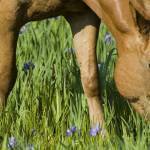What Is It About Spring Grass That Makes My Horse’s Body Grumble?

For most horsemen, spring is a welcome season. Among other reasons, spring brings the green up of pastures. While grass seems the most natural of feedstuffs for horses and ponies, it can stir up health concerns in susceptible individuals.
When it comes to consumption of spring pasture, horses and ponies hardly hold back; horses can consume over 3% and ponies up to 5% of body weight daily. “Given that horses and ponies usually consume 1.5-2% of their body weight in forage and feed to maintain body weight, these numbers alone explain why horse owners run into problems with lush grass,” said Kathleen Crandell, Ph.D., a nutritionist with Kentucky Equine Research.
Despite its nutritional benefits, spring grass can be high in sugar and starch, depending on the type of grass. “Levels of nonstructural carbohydrates (NSC) as high as 40% dry matter have been recorded in certain grasses. Cool season perennials—like ryegrass, timothy, orchardgrass, bluegrass—are especially predisposed to accumulating sugars and fructans,” explained Crandell.
Let’s review some of the common issues that can spring up along with green grass.
Gassiness. Horses on lush grass often expel excessive amounts of gas. Issues arise because the high carbohydrate content of lush grass may cause rapid fermentation of fiber in the hindgut, changing the microbial balance, and an increase in gas-producing microbes can occur. Any shift in the microbial population of the digestive tract can cause excessive gas production. The microbes that ferment sugars and fructans produce copious amounts of gas. “If there is good flow to the digesta in the tract, which is often the case with high-moisture spring grass, the gas will be easily expelled, although it may cause mild discomfort,” Crandell said.
She added, “Horses that are on pasture 24/7 during the winter and into the spring as the grass begins to green up have fewer problems than those who are suddenly introduced to grass because the intestinal microbiome has time to adapt to the changes gradually.”
Loose manure. A change in manure is common when horses consume lush spring grass, most likely because of the elevated water content of grasses, which can reach 85%. If the horse’s manure has green-cowpie consistency when first allowed to graze in the springtime, then the cause is probably the new diet, not disease, Crandell said.
However, horses can develop pathological diarrhea, particularly if they are allowed full-on access to spring grass without acclimation. A dramatic shift in the makeup of the hindgut microbiome, as described previously, can make the horse more susceptible to blooms of pathogenic bacteria that naturally reside in the hindgut. Always consult with a veterinarian when drastic changes occur in a horse’s manure, especially if it is watery and lasts more than a day or two.
Colic. Access to pasture is generally associated with a decreased risk of colic. When it comes to spring grass, though, colic risk rises, primarily due to changes that occur in the gastrointestinal environment consequent to overconsumption.
Further, certain horses may have a problem transitioning from a high-fiber diet of hay or mature grass to lush grass, which has a much lower fiber content. Lack of fiber may cause intestinal upset. This is one reason why many owners offer hay to horses at the same time they’re consuming lush pasture grasses.
Laminitis. Several modes of action may cause laminitis depending on the individual horse and its susceptibility.
One chain of events involves the hindgut. When a horse consumes excessive amounts of spring grass, some of the sugar in it bypasses digestion in the small intestine and ends up in the hindgut. This produces a bloom of lactate-producing gram-negative bacteria that rapidly ferments the sugar and fructans. The byproduct of this fermentation is increasing amounts of lactic acid, which drop the pH of the hindgut. As the pH decreases, other microbes die, releasing endotoxins, reactive amines, and exotoxins into the bloodstream. These are thought to adversely affect circulation, increase inflammation, and destroy lamellar basement membranes in the hooves, causing laminitis.
Another mode of action implicates insulin dysregulation. Consumption of high-sugar grasses causes a rise in blood glucose, which triggers a release of insulin in an attempt to reduce glucose levels by helping to usher it into cells. If a horse or pony is insulin resistant, this mechanism malfunctions, so the pancreas releases more insulin, gradually increasing levels of insulin in the bloodstream. This hyperinsulinemia triggers alterations in blood flow to the hoof, boosts expression of lamellar pro-inflammatory cytokines that activate inflammation, and alters glucose metabolism within the hoof lamellae.
Wood-chewing. Horses require fiber in their diets. Because springtime grass contains little fiber, some horses will look elsewhere to satisfy this need. Horses often chew fence boards or rip bark from trees as a way to consume more fiber. Horses may colic from eating indigestible wood, possibly as a result of impaction. As mentioned above, feeding hay can help alleviate this problem, as it adds palatable fiber to the diet.
Safe springtime turnout requires planning. According to Crandell, management strategies include:
- Gradually acclimating horses unaccustomed to spring pasture by allowing more and more turnout per day and feeding hay the remainder of the day. Start with 20-30 minutes of exposure on the first day of grazing and then increase by 30 minutes every one to two days. Again, this would not be necessary if the horse has access to the pasture throughout the entire transition from winter to spring.
- Using a grazing muzzle to slow the consumption of the fresh grass.
- Continuing to offer hay to horses on pasture to give them more fiber. A flake or two is usually enough to discourage wood-chewing.
- Feeding a research-proven hindgut buffer like EquiShure two to three times a day throughout springtime. EquiShure helps to keep the pH of the hindgut steady, decreasing the likelihood of sweeping shifts in the microbial population.








